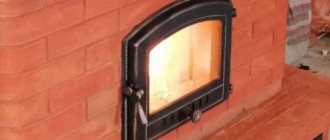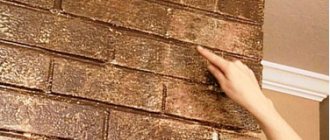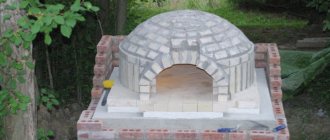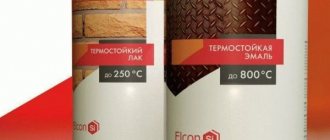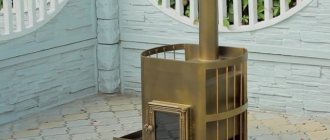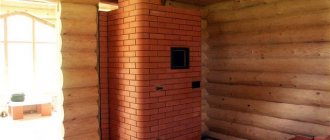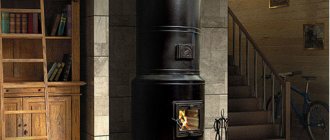Chalk or lime
The easiest way is to do lime whitewash. To do this, dilute lime with water to the consistency of thick sour cream. Before painting, special preparatory measures are carried out: dust, dirt, and loose old clay are removed with a brush, scraper or spatula. It is recommended to add salt to the solution; this will increase its wear resistance and prevent stains from protruding.
If painting a brick oven with chalk, it should be sifted through a sieve in advance, diluted with water or milk, and stirred until smooth. If the mixture acquires a yellowish tint, it is recommended to add blue to it.
It is better to wet the stove painted with lime, then the whitewash will be more effective. Application two or three times is sufficient, but each subsequent layer is applied only after the previous one has completely dried.
Despite its undeniable advantage - safety for human health, such painting has an important drawback - fragility. Heating and cooling of the oven leads to chips, cracks and damage on its surface.
This painting must be repeated every year. Therefore, more modern painting products, for example, paints, are often used.
Types of oven paints
Proper laying of a Russian stove with sufficient thickness of the hearth walls is a guarantee of uniform heating of the room. But it's not only that. The air temperature in it also depends on what the oven is covered with. It is also necessary to take into account the fact that a rough surface has greater heat transfer than a smooth surface, despite the fact that the temperature of the outer part of the furnace can rise to 80C.
For these purposes, many prefer to use enamel and oil compositions. This paint does not interfere with the generation of heat, and it is recommended to give preference to a rich dark color. Aluminum and other shiny compounds will not be effective due to their low thermal conductivity properties.
Synthetic paints are widely used, but it is better not to use oil-based paints. Due to the natural drying oil they contain, hot spots painted by them noticeably darken over time. The paint and varnish industry offers a large selection of special paints designed for stoves and fireplaces that have increased heat resistance.
The color palette of the listed options is not rich, and if it does not suit your taste preferences, you can use latex coating. In this case, painting the stove will be effective only after a rough primer.
How to make painting materials for a brick stove yourself
The main criterion when choosing paint for a brick oven is its heat resistance.
A finishing method such as painting a brick stove with oil or enamel paints will allow it to emit a large amount of heat. The darker the paint color, the more heat the surface of the brick oven can give off. Moreover, it is known that shiny smooth surfaces have worse heat transfer.
When choosing how to paint a brick stove, you should not paint it with aluminum paints and the like. If the thickness of the walls of the furnace hearth meets certain standards, its outer side can reach a temperature of 80°C. Synthetic compounds such as nitro paints, pentaphthalic paints and many others can withstand such heating. Oil paints made from drying oil, if used to paint the surface of a stove, may darken at this temperature.
Today, construction stores sell paints for a brick stove or fireplace that have high heat resistance. However, their color range is quite scarce. If the required shade still cannot be found, the brick oven can be treated with a special primer and painted with latex paint.
Before purchasing the paint required for your brick kiln, you should ensure that it is heat resistant. For this purpose, the best option is to use silicon-organic enamel. After all, it is capable of maintaining its performance qualities at temperatures up to 600°C. As a solvent for this type of enamels, either turpentine or solvent 646 is used. To get a good result, a brick stove should be painted in a thin layer without smudges in 2-3 approaches.
A brick stove can easily fit into the most modern interior design and even become its “highlight”.
Today, interiors designed in chalet, country, and shabby chic styles are extremely popular among homeowners. Their distinctive feature is the naturalization of various details and decorative elements. A Russian brick stove or fireplace would fit perfectly into such interiors as a bright and stylish addition.
These items can be a real highlight. To do this, they can simply be painted with transparent paint. However, before painting the surface, it must be properly prepared. If there are any visible defects on it, they need to be eliminated by filling with putty. The latter is prepared by mixing latex paint and brick flour.
You can achieve a beautiful shade of a brick oven yourself by making your own paint. First, red brick flour is rubbed. Whipped egg whites and milk are added to it until thick. The mixture is thoroughly mixed. You need to paint the stove with a new brush, applying the paint to the surface of the stove that has been preheated to a warm state.
In this case, the brick surface acquires an even red color. This coating is heat-resistant and has increased abrasion resistance. Finally, the stove must be painted with drying oil, which will make the dark red surface matte. If desired, you can get shine by using a special synthetic varnish.
This type of painting of a brick oven is approved by experts. After all, the resulting dense, rough surface promotes the greatest transfer of heat into the room and, having excellent elasticity, prevents the formation of cracks and various defects.
Lacquered brick oven
To coat brickwork with varnish, you need to perform a number of construction activities:
- clean contaminated areas
- remove defects from cracks and chips with putty
- repair faults
Minor defects are removed with a mixture of brick flour, to which egg whites and milk are added. Apply the solution to damaged areas in the masonry with a brush. You need to wait for the work done to dry completely; the paint cannot be rushed and leads to destruction.
Any painting does not hide flaws in the area being treated; on the contrary, it will highlight the flaw, so you should get rid of them carefully, without missing even a small crack. When starting to varnish the stove you need:
- open jar of product, mix thoroughly
- add solvent
- turpentine
Additives are acceptable if the consistency of the varnish is insufficient for work; they are dissolved with one selected substance. The brush for work becomes hard, cover the surface in several layers, after each it is necessary to wait for it to dry completely. The coating is completed with a finishing touch, the master chooses the last layer himself, it can be the third or fourth, until a decent appearance of the stove is achieved.
A properly built Russian stove is capable of delivering over 50% of the heat to heat a room; such a stove is ideal for a summer house. You can use it to make preparations for the winter, cook food, dry clothes and warm yourself from its warmth. However, the expected effect may not be achieved if it is not painted correctly.
Since ancient times, stoves have been painted with lime by hand, and for good reason, the rough surface gives off more heat. Tiles were used to decorate “saviors” from frost. such stoves were a work of art and were an attribute of a rich home. Modern materials have made great strides in the variety of cladding for stoves and fireplaces. but the “old-fashioned” methods are still considered the most common. How to paint a brick oven?
Live fire always fascinates. This is why stoves and fireplaces are still popular. How to paint a brick stove in a house? It must fit successfully and harmoniously into the existing environment. And the coating should be beautiful, durable and safe.
The stove requires maintenance. And it doesn’t matter where it is, in the house or in the country. There are several reasons for this:
- Brickwork needs protection. Over the years, cracks form on it, and the masonry may collapse.
- The coating improves heat transfer, especially if it is rough.
- For a better look. Sometimes a red brick stove or fireplace does not at all match the interior of the entire room.
Brick processing can also be done with home-made paints.
Consider the option of homemade brick paint. The brick is ground into fine crumbs and sifted through a sieve so that the mass is absolutely homogeneous. Then mixed with country milk and egg whites. Using a wide brush, apply a solution to the warm oven, which should resemble liquid sour cream.
Painted brick will get slightly dirty. To eliminate this drawback, it is recommended to apply a layer of beaten egg white to a well-heated oven. This heat-resistant paint will protect the brickwork well from moisture and dirt. This method has been used since ancient times. This type of coating is called stove varnish.
There is also a very economical option for making homemade paint. Turpentine and PF varnish are mixed in equal proportions. It can be tinted with dry dyes, or even dried gouache.
What modern groups of paints can be used for a brick stove? Special heat-resistant materials are used. There are several types:
- Silicate paint. It is based on liquid glass, with the addition of mineral fillers and pigments. It has good heat resistance.
- Water-based paint. Made from acrylic emulsion and water. Does not respond to temperature fluctuations. The choice of colors is quite wide. Durable.
- Silicon-organic enamel. A variety of organic resins, polymers and dyes are used for manufacturing. Resistant to high and low temperatures. A very large number of colors.
- Heat-resistant paint. Almost ideal option. Withstands temperatures up to 600°C. Has increased strength and long service life. Large selection of colors.
- Oil paints, varnishes and drying oils. They are rarely used, since under the influence of high temperatures they change color unevenly and smell unpleasant.
- Latex compounds. A combination of latex and acrylic. A very good material, but it has one big drawback: it is an environment for the development of fungus and mold.
The choice of paint for brick fireplaces is no different. It must have the same characteristics as stove paint.
Since styles such as country and Provence are now in fashion, decorating stoves and fireplaces with various ornaments looks very colorful. They can be applied with a brush or use a stencil. A fireplace decorated in this way will fit perfectly into such an interior.
How to paint a brick oven
How to paint a brick stove in a house? A Russian stove, built according to the rules from brick, gives half of the heat it releases to the room. But its quantity depends on the material covering its surface. In this case, a rough surface gives off more heat than a smooth one.
In villages, stoves have long been painted with lime, and the owners of rich houses decorated the stoves with tiles, turning the structures into real works of art. The article will tell you how to paint a brick stove?
There are several reasons for painting brick stoves:
- The owners are drawn to aesthetics. If previously the stove in a village house was the only heating device, now fireplaces and stoves serve as interior elements that need to be harmoniously integrated into the home.
- Finishing the surface of the stove with paints prevents the appearance and then increase of cracks in the bricks. makes the surface smooth.
- After painting, heat transfer into the room increases.
What to look for when choosing paint
Often, many home owners, when choosing paint for the stove, pay great attention to taste preferences, forgetting about its quality characteristics. The paint must be heat-resistant, only in this case it will satisfy all the needs and wishes of consumers. Organosilicon enamel, for example, has such properties. It retains them even when the surface is heated to 600C. Its solvents can be turpentine or 646 solvent. Apply it 2-3 times after the previous layer has completely dried.
Advantages of heat-resistant paint:
- it has excellent wear resistance and heat resistance;
- such a coating has electrical insulating properties;
- with its help, brickwork is protected from oxidation, which increases its strength and endurance;
- The painting process is simple and does not require preliminary priming;
- The shelf life of its operational characteristics is long - about 10 years.
Disadvantages of heat-resistant paint:
- the composition has quite aggressive properties, which can be dangerous to the health of humans and domestic animals;
- the paint has an unpleasant odor, which makes it impossible to use it in a house where people with respiratory problems live;
- the compositions have a long drying period, which may be associated with certain inconveniences;
- The presence of toxic substances in their composition makes it mandatory to use respiratory protection and skin surface protection during work.
Heat-resistant paint is toxic and very harmful to health
Properties
Previously, no one covered brick walls with anything. Not everyone today is concerned with finishing brickwork. Whether finishing is needed if the brick already looks great can be understood by assessing its performance characteristics.
We suggest you familiarize yourself with what kind of wood is best to build a bathhouse from?
No matter how good the masonry is, in regions with a harsh climate, and in Russia there are plenty of such areas, “varnish help” will not hurt neatly laid out rectangles. The facade of a private house, treated with varnish, gains additional attractiveness and does not require repairs much longer than its untreated “brothers”.
Bricks coated with a special varnish composition:
- protected from moisture penetration;
- become more durable due to the product penetrating deep into the building material and partially changing its structure;
- lose sensitivity to various chemicals and solvents;
- do not lose their original color when exposed to ultraviolet radiation;
- gain increased resistance to high and low temperatures;
- become more attractive;
- extend the service life;
- receive protection from fungal diseases and mold;
- gain the ability to repel dirt.
Water-based paint - the right choice
Water-based paint deserves special attention, so I would like to draw your attention to it. Applying water-based paint will allow the stove to work efficiently and make the surface look like new. Therefore, many homeowners today prefer it. The material, which has a dispersive nature, is becoming increasingly popular in painting walls, ceilings and other surfaces. The paint has many positive reviews from owners of home stoves. You can also opt for water-based paint because with such a coating the brick “breathes” and provides good heat transfer.
The advantages of using it to paint the stove:
- The paint dries very quickly, but subject to constant high temperature.
- The composition is absolutely safe for the health of people and animals.
- Unlike other products, this paint does not have an unpleasant odor.
- The ability to create your own, individual palette using various pigments, while this is impossible with other paints.
- The painting process does not require much effort and time. You can use a brush, sponges, a special roller, or other convenient accessories, which greatly simplifies the work.
Pros and cons of heat-resistant paint
Heat-resistant paint significantly increases the wear resistance and strength of brickwork, protecting it from the harmful effects of the environment.
The composition applies to the surface easily and evenly. And before use there is no need to additionally prime the oven. This paint retains its quality characteristics for 10 years.
Despite all their attractiveness, such funds have disadvantages. Heat-resistant ones require increased attention when working with them, as they contain toxic substances.
Due to the pungent odor, painting must be carried out in a respirator, and the room must be well ventilated.
And one more significant drawback - you will have to wait a long time for the paint to dry completely.
Recommendations for stylish oven design
Nowadays, there is a clearly expressed trend towards naturalization of interior elements and details. One cannot ignore such a bright and imaginative component of the design as the stove. It emphasizes the color and Russian style, since it has long been considered an integral part of Russian life and culture. The growing passion for rustic styles (country, Provence, etc.) makes it possible to use a competent approach to painting a stove to turn it into a spectacular and colorful element of the home, emphasizing the refined taste of the owner.
A beautifully designed stove will add its own zest to the interior design
Even by covering the stove with transparent paint, you can turn it into a work of art. But, before painting a brick stove, you need to give it an appropriate, natural look. Having cleared it of dust and debris using putty, first eliminate all possible defects (cracks, damage, etc.). You can make your own putty by adding brick flour to latex paint.
Painting the stove surface
Before painting the stove, you should make sure whether it needs to be restored? Restoring the surface of the stove with your own hands will not take much effort and time, but will protect it from cracks, damage and the negative effects of time.
Recommendations for performing the work:
- The outer part of the warm oven is treated with a brush with a special environmentally friendly varnish that is resistant to prolonged high temperatures and mechanical damage. To do this, you can use a mixture - varnish, prepared by yourself. Make a mixture of flour obtained from tap bricks, milk and 10 egg whites. It should be thick and viscous, then the surface will be a uniform red color.
- To give the surface a dark red matte hue, you can apply drying oil.
- If you want to get a shiny effect, you can coat the stove with oil or synthetic varnish.
- Shades of latex coloring composition will help satisfy color preferences.
A mixture of turpentine and varnish PF-283 can also be used as paint for the stove. Taking equal proportions of these substances, a transparent, slightly matte substance is obtained. It can be given the desired color. To do this, the dried gouache, ground into powder, is first carefully sifted, then added to the mixture, achieving the desired result.
The nuances of coloring
Before wondering how to paint a brick stove, you need to know for sure whether its surface has been previously plastered. If the structure is old, then most likely it was used for its intended purpose, that is, it heated the room and served as a place for cooking. Such stoves are white because they were first plastered and then whitened with chalk or slaked lime.
Before painting begins, all loose material from the stove must be cleaned off. For this, a construction brush with metal bristles (brush brush) will be useful, or a narrow spatula will do. If the material is easily removed, then it may be more advisable to remove it down to the brickwork, in which case any paint can be chosen for fireplaces and stoves.
The next step is to remove all debris and clean the surface of dust. Next, either with your own hands or with the help of a professional, seal cracks, holes and seams. Nowadays, specialized stores offer ready-made mixtures that are suitable for working with brick kilns.
Preparing the surface for processing
It is worth understanding that there are several reasons when you can resort to painting a brick stove. So you can approach this issue from an aesthetic, practical and safety perspective. As for aesthetics, a stove in a house is needed not only to heat the home and make it comfortable to live in, but also to maintain the interior and create a special coziness. On the practical side, after the fireplace is painted, the heat output increases and the stove surface is leveled.
We suggest you read: You can pour concrete in cold weather
Note! From a safety point of view, thanks to painting, it is possible to prevent the appearance of microcracks on the brick and, as a result, prevent fire in the home.
There are several options for painting the structure. You can do this:
- enamel;
- oil paint;
- drying oil;
- heat-resistant varnish.
As for enamel, it is durable, moisture-resistant, interacts well with other materials and has increased durability. Experts provide the following figures: enamel can withstand about 200 sudden temperature changes. It is worth noting that the color choice is very scarce.
Heat-resistant oil paint for stoves is the best solution, since there is a large selection of colors, the paint can withstand temperatures of 600 degrees Celsius, is guaranteed to protect the brick from oxidation, and has increased resistance and durability. In addition, it is easy to apply and does not require any additional priming on the outside. However, there are disadvantages such as an unpleasant odor, toxicity and long drying time.
Drying oil is a material that cannot change the color of the brick, but only make it a little darker. As for the positive qualities, this coating is reliable and safe. The only downside is the price.
Heat-resistant varnish is a coating that can improve the technical characteristics of a brick surface.
Note! The peculiarity of its use is that it can be diluted with gouache to obtain the desired color with a tint.
Metal furnaces are highly susceptible to oxidation degradation due to their molecular composition. Trace elements of the metal react with air, resulting in oxidation. High temperatures speed up this process significantly. As a result, the service life of the furnace equipment is reduced.
Cast iron is a fairly strong metal that can withstand prolonged exposure to high temperatures. According to some sources, you don’t have to resort to painting the metal, but it’s better to do it. An excellent option for a cast iron stove is to use water-based acrylic or polyurethane paint, which has already proven itself to be excellent. In addition, a cast iron alloy will be able to withstand even disturbances during painting more favorably.
The painting process itself looks like this. First, pre-clean the surface with a wire brush. Next, the oxidation marks are sanded using five percent sulfuric acid, and the mixture is washed off with a soap solution. Then the metal is degreased with a solvent and coated with paint. This is the whole dyeing technology. In this case, painting of a metal stove should proceed evenly. All corners with seams should be reworked as much as possible.
Note! If you do not want to drip onto the surrounding elements of the oven, you must use cellophane with masking tape.
Brick ovens
You can paint a brick stove using enamel, oil paint, drying oil and heat-resistant varnish.
In the first case, the structure will be protected from moisture and will have good strength and durability. In the second case, the plastered and painted surface will be able to withstand high temperatures, and in the latter cases it will be able to give strength to the brick.
